Physical Address
304 North Cardinal St.
Dorchester Center, MA 02124
Although a detailed understanding of nuclear physics is not necessary to interpret magnetic resonance imaging (MRI) studies, it also is unacceptable to read passively whatever images you are given without concern for how the images are acquired or how they might be improved. Radiologists should have a solid understanding of the basic principles involved in acquiring excellent images. This chapter describes the various components that go into producing high-quality images, stressing the fundamental principles shared by all MRI scanners.
Every machine is different. Clinical scanners are now available at strengths ranging from 0.2 tesla (T) to 3.0T. Additionally, each vendor has its own language for describing its hardware, software, and scanning parameters, and an entire chapter could be devoted to deciphering the terms used by different manufacturers. Time spent learning the details of your machine with your technologists or physicists would be time well spent. If you are interested, read one of the excellent discussions of MRI physics in articles or other textbooks because, for the most part, in this book we leave the physics to the physicists.
Motion is one of the greatest enemies of MRI ( Fig. 1.1 ). It can arise from a variety of sources, such as cardiac motion, bowel peristalsis, and respiratory movement. For most musculoskeletal applications, motion usually stems from body movement related to patient discomfort. Patient comfort is of paramount importance because even if all the other imaging parameters are optimized, any movement would ruin the entire image.
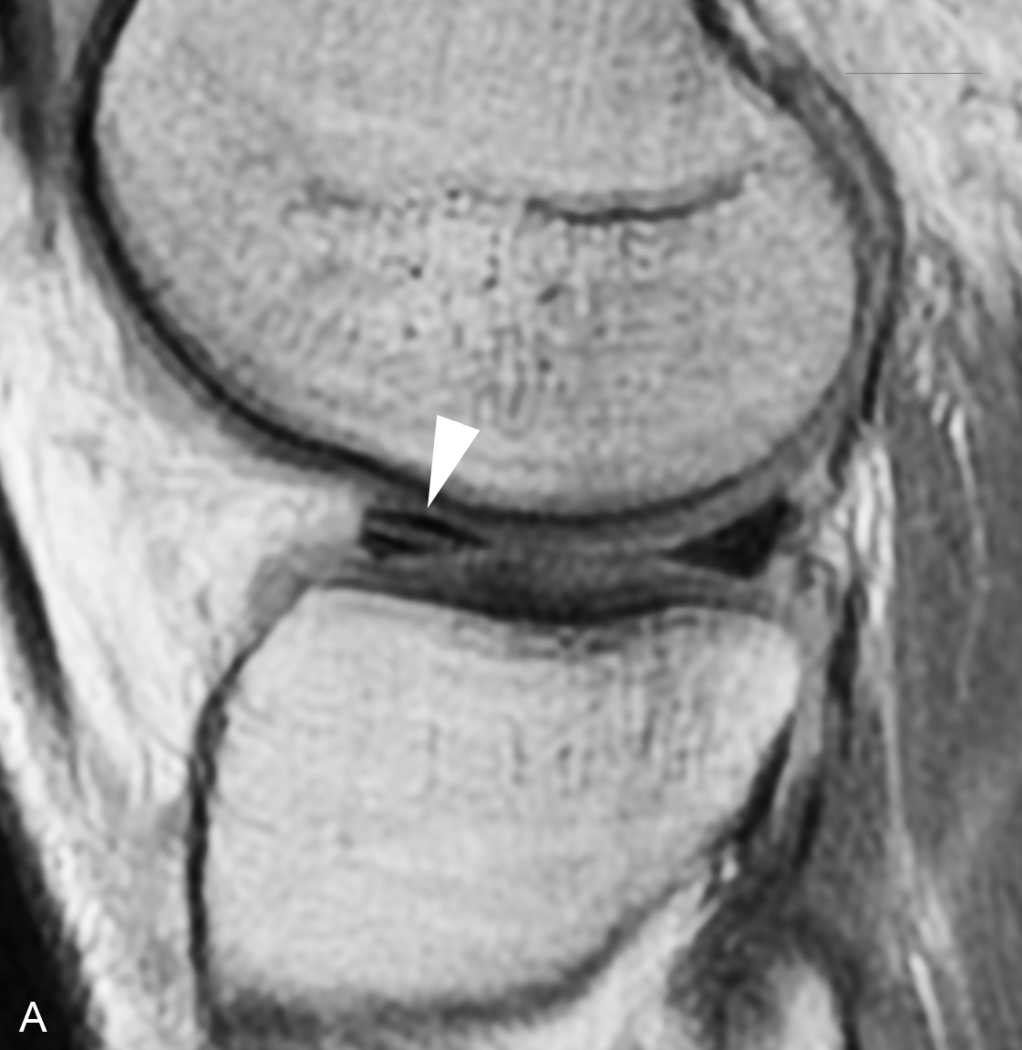
Patient comfort begins with positioning. Every effort should be made to make the patient comfortable, such as placing a pillow beneath the knees when the patient is supine to reduce the stress on the back or providing padding at pressure points. When the patient is in a comfortable position, passive restraints, such as tape, foam rubber, or sandbags, can be used for maximal immobilization. Music via headphones can help alleviate anxiety. Short-acting sedation may be required for claustrophobic patients.
Another cause of patient motion is a prolonged examination, which is one reason why streamlined imaging protocols are useful. By designing efficient imaging sequences, the necessary scans are obtained in as short a time as possible, resulting in better patient compliance, improved technologist efficiency, and maximal scanner throughput. Standardized protocols also reduce the need for direct physician oversight during the scan and allow for improved image interpretation because the radiologist views the same anatomy in the same imaging planes utilizing the same sequences each time.
Signal is the amount of information on an image. Other factors are important, but if the image is signal-poor (i.e., “noisy”), even the best radiologist would be unable to interpret it ( Fig. 1.2 ).
| ↑ Signal/↓ Resolution | ↑ Resolution/↓ Signal |
|---|---|
| ↑ Slice thickness | ↓ Slice thickness |
| ↑ Field of view | ↓ Field of view |
| ↓ Imaging matrix | ↑ Imaging matrix |
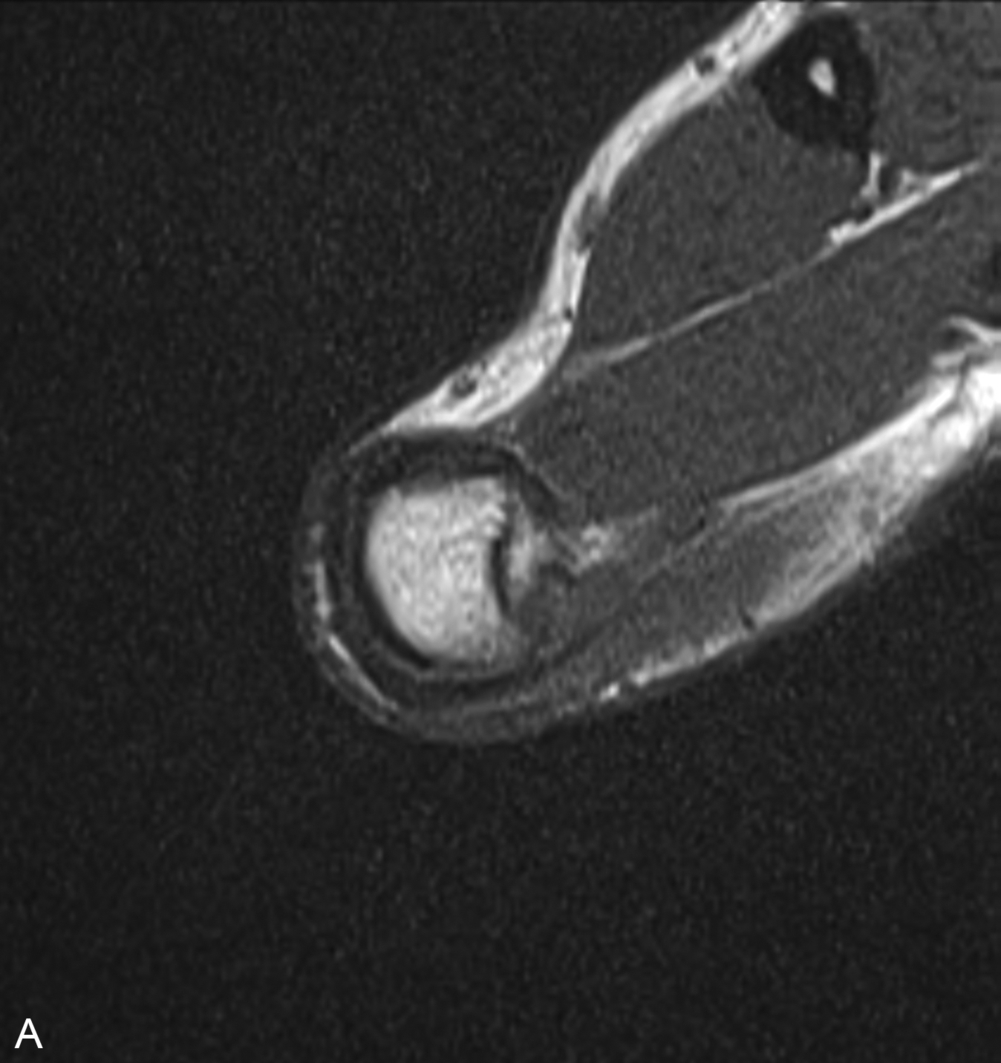
Each image is composed of voxels (volume elements) that correspond to small portions of tissue within the patient. One dimension of the voxel is defined by the slice thickness . The other dimensions are determined by the field of view and imaging matrix (number of squares in the imaging grid) ( Fig. 1.3 ). Because the signal is proportional to the number of protons resonating within each voxel, anything that increases the size of the voxel would increase the signal ( Fig. 1.4 ). Increasing slice thickness or field of view or, alternatively, decreasing the matrix (spreading the imaging volume over fewer but larger boxes) would increase the signal.
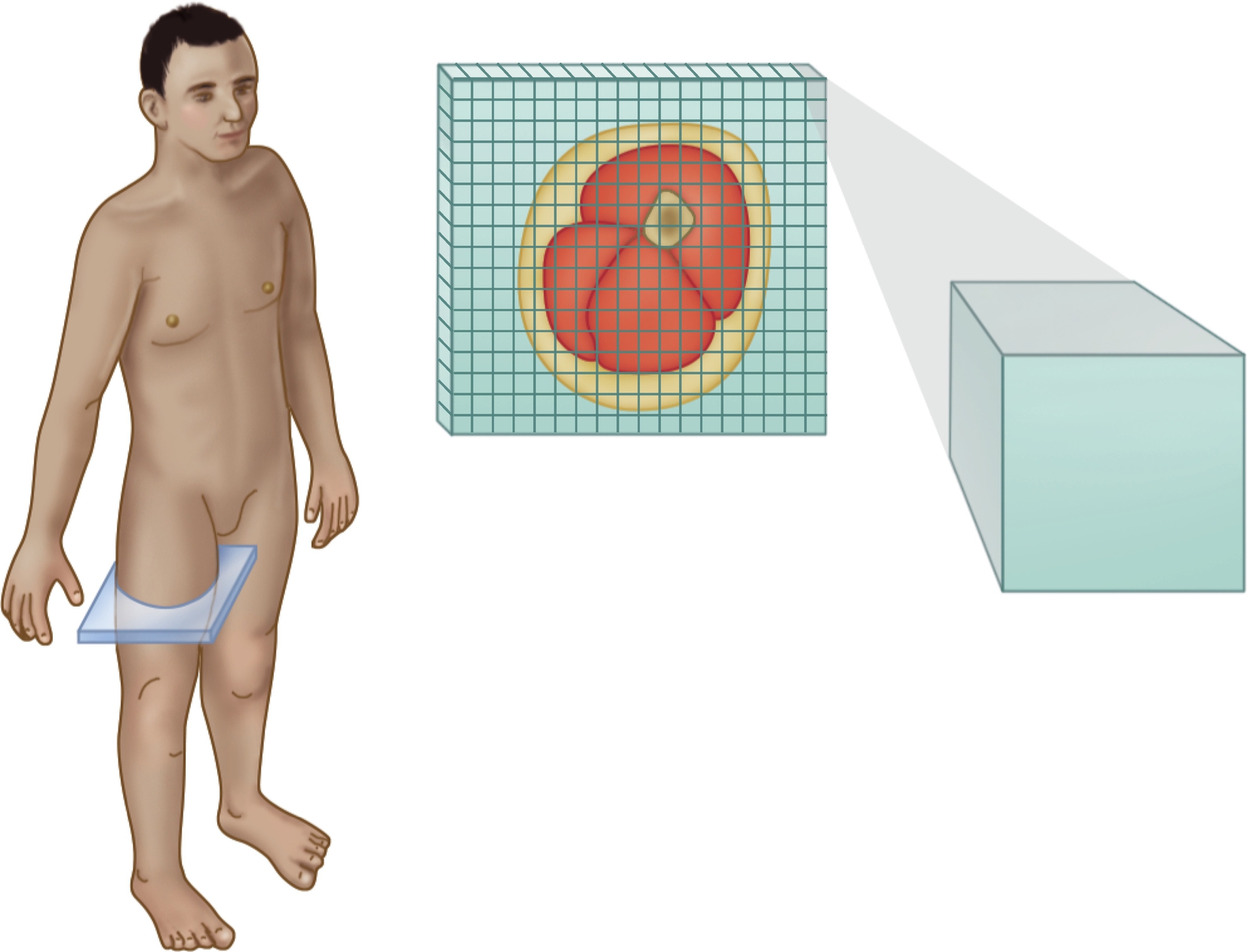
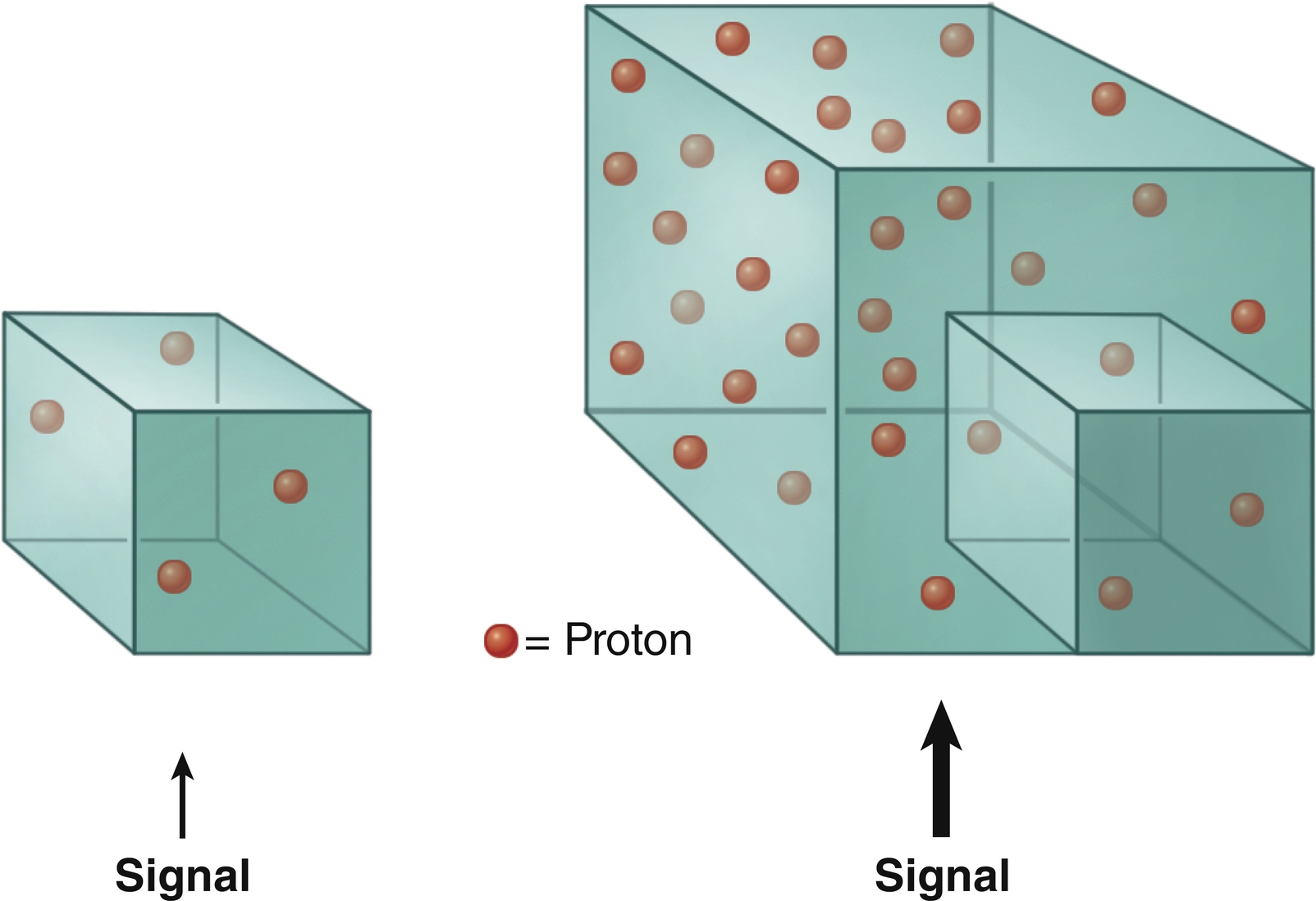
Another factor that affects the signal is the number of signal acquisitions (also known as the number of signal averages or number of excitations [NEX] ). A signal average of 2 means that the signal arising from the protons in each voxel is collected twice, resulting in a doubling of the imaging time. This results in an increase in the signal-to-noise ratio of the square root of 2. As a result, this is a relatively time-inefficient method for improving signal.
Finally, signal may be adversely affected if the slices are obtained too close together because of the phenomenon of “cross talk.” When adjacent slices are acquired, some interference from one slice may spill over into the adjacent slice, resulting in increased noise. This is especially true for T2-weighted sequences. This effect is lessened by interposing a “gap” between the slices (a small portion of tissue that is not imaged), resulting in decreased noise and increased signal. Typical gaps range from 10% to 25% of the slice thickness. The larger the gap, the greater the amount of unimaged tissue, and the greater the possibility of missing a small lesion.
Sequences can be employed that can eliminate the artifacts due to motion, pulsatile flow, and cross talk unique to each magnet manufacturer. These sequences are particularly useful if the patient demonstrates anxiety or has an involuntary spasm that can preclude obtaining desirable images.
Now that we have discussed several ways to improve the signal of the image (also known as increasing the signal-to-noise ratio ), we need to look at the second major factor that makes for a good image: resolution . Resolution is the ability to distinguish small objects. It is absolutely critical in most musculoskeletal applications, given the relatively small structures that are often the subject of inquiry.
As in life, there is no such thing as a free lunch in MRI, and any changes designed to improve resolution negatively affect the signal. Decreasing the size of the voxel (by decreasing slice thickness, decreasing the field of view, or increasing the imaging matrix) not only would improve resolution but also would decrease the number of protons in each voxel and decrease the signal (see Table 1.1 ). Consequently, when designing imaging protocols, there is always a compromise between (1) maximizing signal and (2) optimizing resolution ( Fig. 1.5 ). Another factor, coil selection, can help minimize this tradeoff.
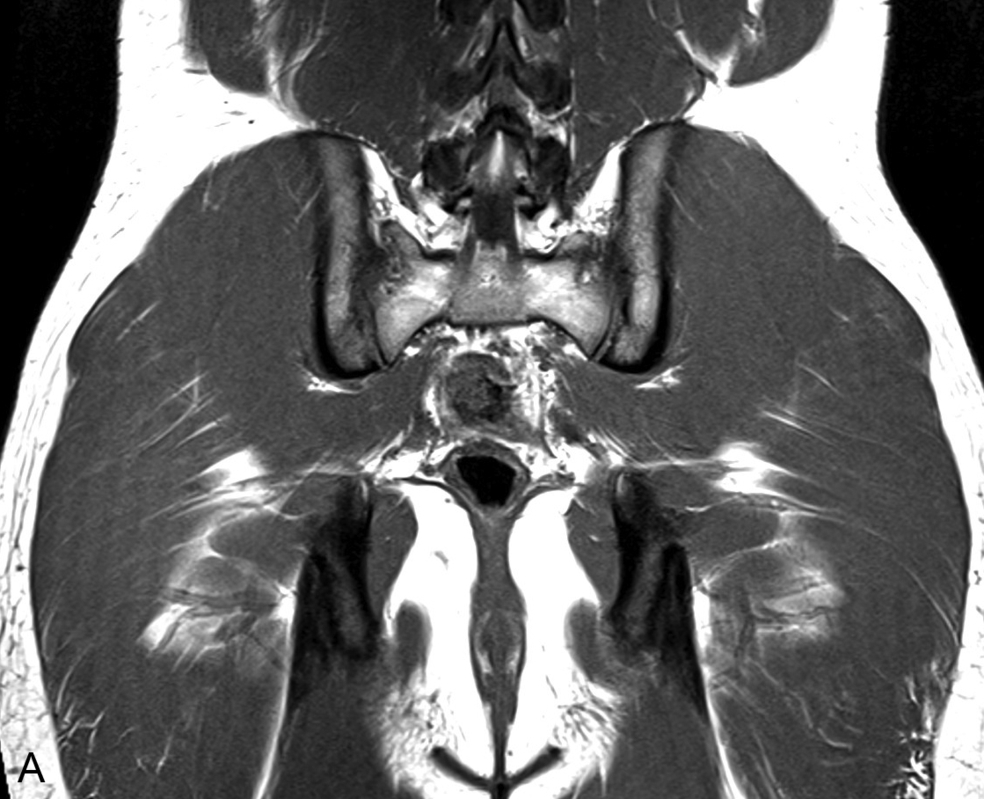
An MR image is created using the signal that returns from resonating protons within tissue. Just as it is easier to hear a speaker’s voice the closer he or she is to you, the closer the receiver coil is to the tissues of interest, the better the signal and the lower the noise.
In MRI, every attempt should be made to use the smallest coil possible to produce the maximum signal. Coils that can be placed on or close to the body part of interest are called surface coils and result in markedly improved signal compared with the body coil . A factor that must be considered when selecting a coil relates to its size. A coil must be able to detect signal from the entire length and depth of the tissues of interest; for a flat surface coil, the depth of penetration equals roughly half of the coil’s diameter or width. Beyond this distance, the signal begins to drop off, as evidenced by decreasing signal in that region of the image. To avoid this problem, so-called volume coils are often used in the extremities. These encircle the arm or leg, providing uniform signal throughout the tissues of interest. Most coils also are now constructed with a phased array design. A phased array coil is composed of several smaller coils placed in a series, resulting in maximal signal from each small coil and from each segment of tissue covered by the coils. The use of a surface coil usually provides more than adequate signal and allows for the use of high-resolution imaging parameters. Selecting the appropriate coil is paramount to obtaining signal rich and high-resolution images.
Both computed tomography (CT) and MRI are capable of producing high-resolution scans, but the superior soft tissue contrast of MRI (the ability to differentiate types of tissue based on their signal intensities) sets it apart. A CT image is based on the x-ray attenuation properties of tissues, whereas soft tissue contrast in MRI is related to differences in proton resonance within the tissues. The protons within fat resonate differently than the protons in fluid, and by changing the imaging parameters at the MRI console, differences in these tissue-specific properties can be emphasized. This is known as weighting the image. Tissues can be differentiated based on their signal intensities on various sequences. The signal intensity of a tissue on MRI should be described in relative terms (e.g., hyperintense relative to muscle) because the gray scale values of the image are not assigned in a quantitative fashion, as with CT, but are scaled relative to the brightest voxel on the image.
The collection of specific imaging parameters selected for a single scan is called a pulse sequence . A typical musculoskeletal examination includes three to six sequences obtained in various anatomic planes. There are many different kinds of sequences, and each has specific strengths and weaknesses. We do not want to get bogged down in technical details at this point; in the following discussion, typical imaging parameters for each pulse sequence are provided in parentheses. These are summarized in Table 1.3 , and there is a glossary at the end of the chapter to help with understanding any unfamiliar terms.
| Sequence | Strength | Weakness |
|---|---|---|
| Fast Spin Echo | ||
| T1 | Anatomic detail Fat, subacute hemorrhage Gd-DTPA enhancement (with fat saturation) Marrow pathology |
Poor detection of soft tissue edema and other T2-sensitive pathology Not as sensitive as STIR or FSE-T2 with fat saturation for marrow pathology |
| Proton density | Anatomic detail Meniscal pathology |
Poor detection of fluid and marrow pathology when not combined with fat saturation |
| T2 | Detection of fluid and many pathologic processes Excellent detection of marrow pathology when combined with fat saturation Good in patients with metal hardware (↓ susceptibility effects) |
Poor detection of marrow pathology when not combined with fat saturation |
| Gradient Echo | ||
| T2* | Fibrocartilage (meniscus, labrum) Loose bodies and hemorrhage (↑ susceptibility effects) 3D imaging |
Poor detection of marrow pathology at high field strengths Metallic hardware (↑↑artifacts due to susceptibility effects) |
| STIR | Marrow and soft tissue pathology | Should not be used with Gd-DTPA |
| Sequence | TR (msec) | TE (msec) | TI (msec) | Flip Angle (°) | ETL |
|---|---|---|---|---|---|
| T1 | ≤ 800 | ≤ 30 | N/A | 90 | N/A |
| Proton density | ≥ 1000 | ≤ 30 | N/A | 90 | N/A |
| FSE T2 | ≥ 2000 | ≥ 50 | N/A | 90 | 2-16 |
| FSE STIR | ≥ 2000 | ≥ 30 | 120-180 | 180 → 90 | 2-16 |
| GRE T1 | Variable | ≤ 30 | N/A | 70-110 | N/A |
| GRE T2* | Variable | ≤ 30 | N/A | 5-20 | N/A |
Conventional spin echo pulse sequences include T1-weighted (T1W), T2-weighted (T2W), and proton density (PD)–weighted sequences (see Table 1.3 ).
T1 (repetition times [TR] < 800 msec; echo times [TE] < 30 msec) is considered a “short TR, short TE” sequence. Fat and subacute hemorrhage are bright on these images ( Fig. 1.6 ). Proteinaceous fluid (as in an abscess or ganglion cyst) may be of intermediate or high signal intensity, depending on the protein content. Most other soft tissues are of intermediate to low signal intensity on T1W images, and fluid is especially low (hypointense relative to muscle or intervertebral disk) ( Fig. 1.7 and Table 1.4 ). T1W images are useful for delineating anatomic planes, marrow architecture, fat content within masses, and subacute hemorrhage. T1W sequences are also used to evaluate tissue enhancement after intravenous (IV) administration of gadolinium–DTPA (Gd-DTPA) (see later in this chapter).
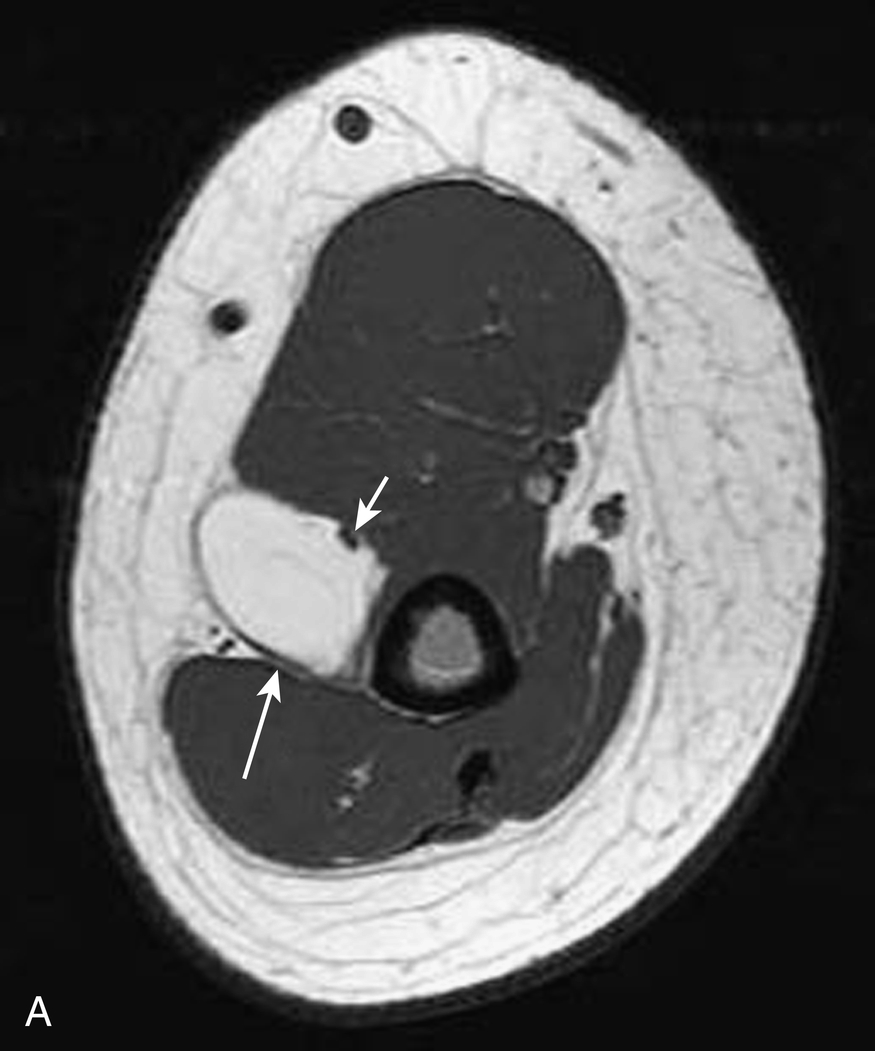
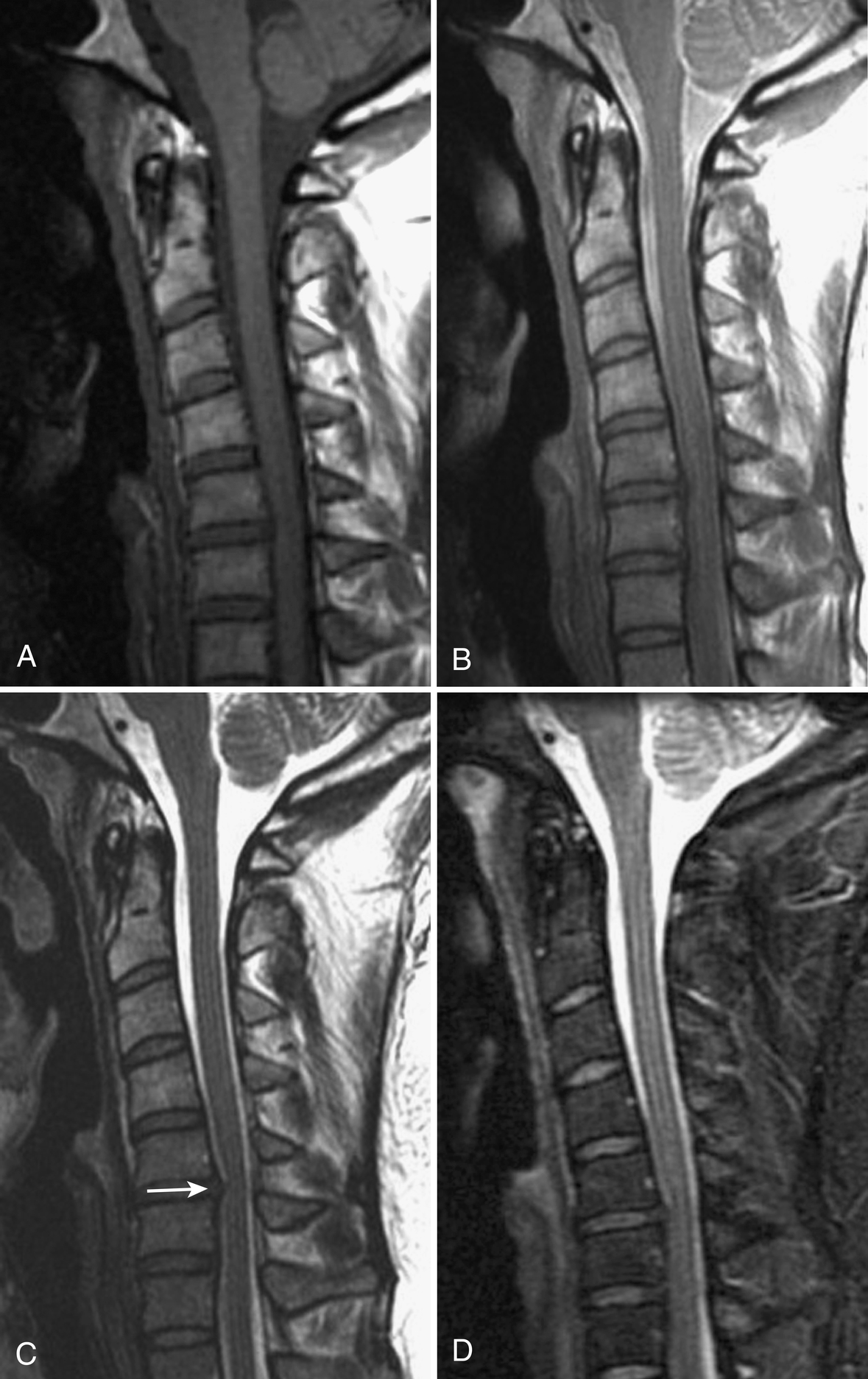
| T1 | T2 | |
|---|---|---|
| Fat | ↑↑ | ↑ |
| Subacute hemorrhage | ↑↑ | ↑↑ |
| Proteinaceous fluid | ↑ | ↑↑ |
| Fluid | ↓ | ↑↑ |
| Fibrous tissue/scar | ↓ | ↓ or ↑ |
| Cortical bone | ↓↓ | ↓↓ |
| Chronic hemorrhage/hemosiderin | ↓↓ | ↓↓ |
| Air | ↓↓ | ↓↓ |
T2 (TR > 2000 msec; TE > 60 msec) is considered a “long TR, long TE” sequence. Fluid is bright on T2W images (see Fig. 1.7 ). Likewise, most pathologic processes (e.g., tumor, infection, injury) are often highlighted on T2W images because of their increased fluid content. Fat is less bright than on T1W images, and muscles remain of intermediate signal intensity. Conventional spin echo sequences have been a part of most imaging protocols in the past but now are rarely, if ever, used because of their relatively long imaging times. As such, they have been replaced by fast spin echo (FSE) sequences.
PD (TR > 1000 msec; TE < 30 msec) is considered an “intermediate TR, short TE” sequence. Also known as spin density, these images represent a mixture of T1 and T2 weighting, with contrast being primarily a function of the number of protons within each tissue. This sequence also provides good anatomic detail but relatively little overall tissue contrast because of its intermediate weighting (see Fig. 1.7 ).
FSE, also known as turbo spin echo, allows for much more rapid acquisition of images than the conventional spin echo method. Several samples are acquired in the time one sample is obtained with a conventional spin echo technique ( Fig. 1.8 ). The time saved is directly proportional to the number of samples (also designated as the echo train length ). An FSE sequence with an echo train length of 4 would acquire the same amount of information as a conventional spin echo sequence in one fourth the time. Decreased overall imaging time lessens the potential for patient motion. Alternatively, the time saved can be used for obtaining additional signal averages to improve signal. FSE sequences are commonly used in musculoskeletal imaging.
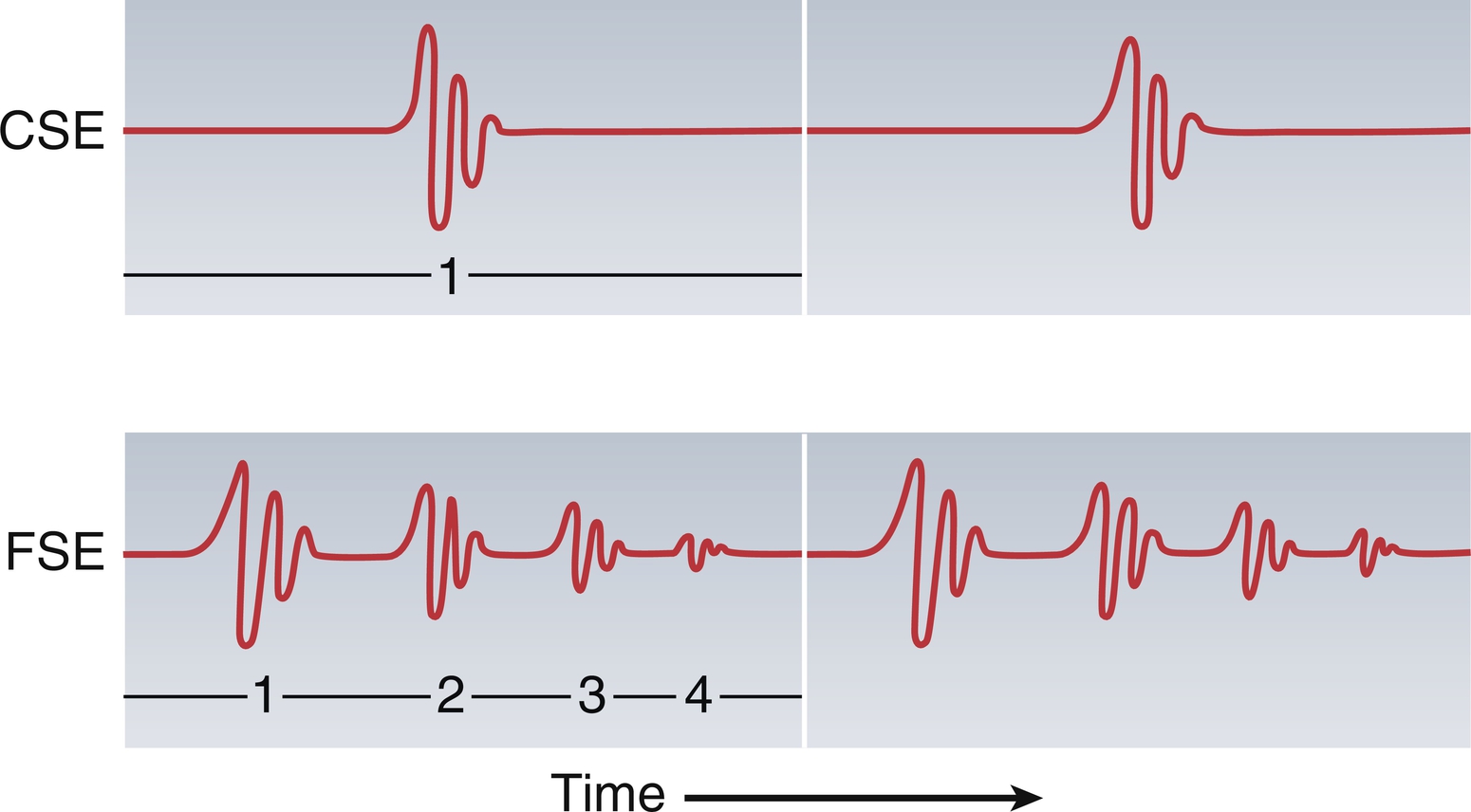
This technique has some drawbacks. First, the signal intensity of fat remains quite bright on FSE–PD and T2W images. Consequently, pathology in subcutaneous fat or marrow may be obscured on these images because of the similar signal intensity of fat and fluid. This problem can be overcome by combining this technique with fat saturation (see later in this chapter) ( Fig. 1.9 ).
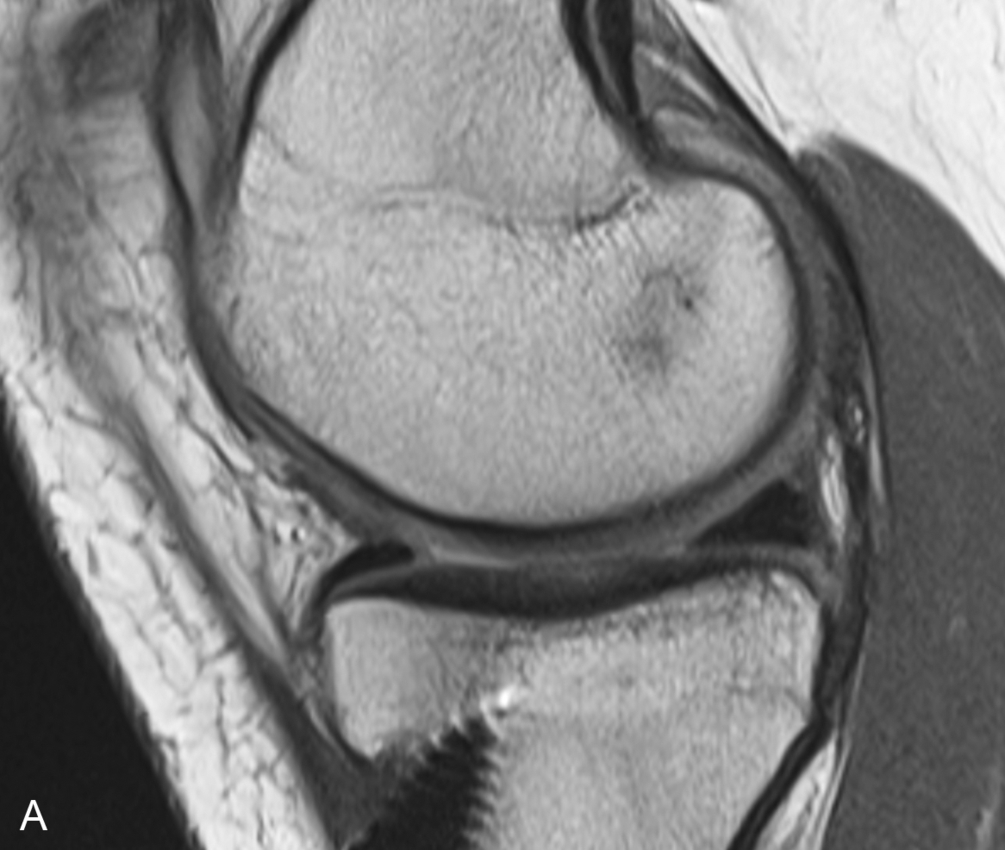
Second, the FSE technique can result in blurring along tissue margins, especially when PD-weighted images are acquired using long echo train lengths (> 4). Although it is tempting to use a longer echo train length to decrease imaging time, the associated increase in blurring may result in missing some types of pathology, such as meniscal tears in the knee ( Fig. 1.10 ).
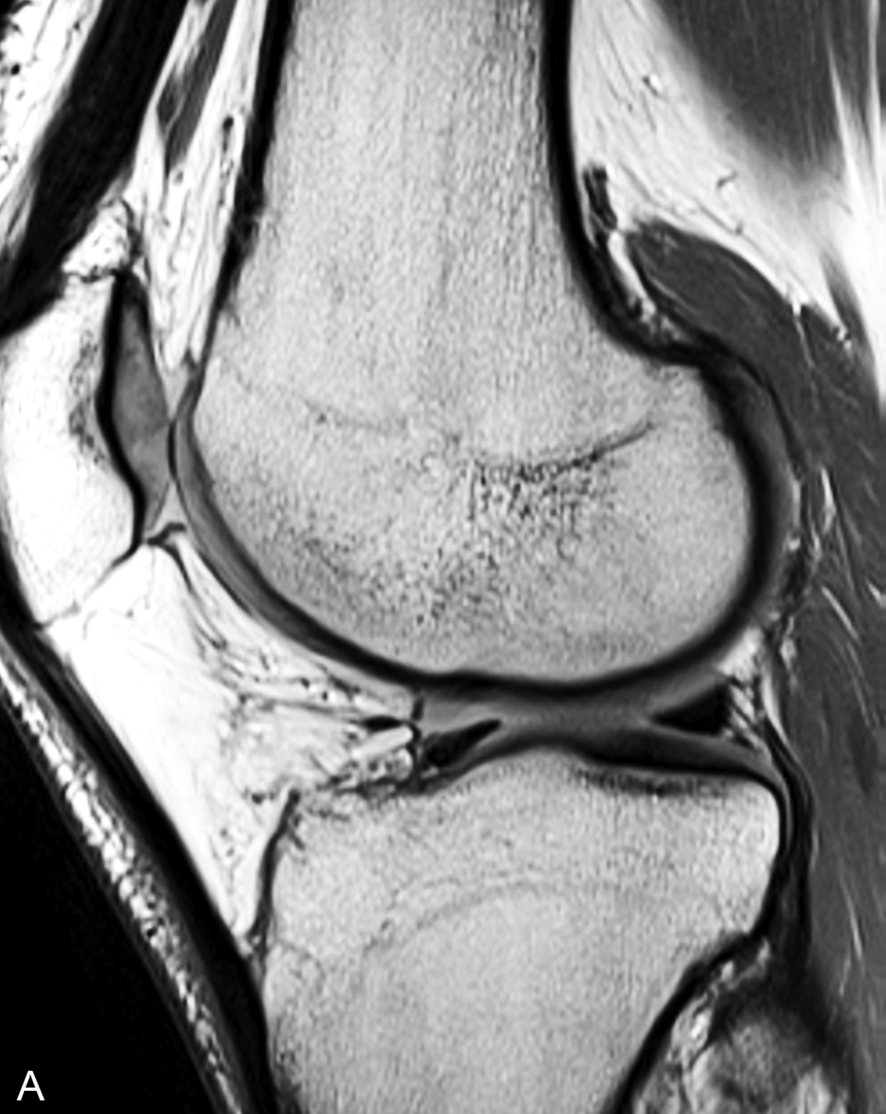
Historically known as short tau inversion recovery (STIR) imaging, inversion recovery (TR > 2000 msec; TE > 30 msec; TI = 120-180 msec) is a fat-saturation technique that results in markedly decreased signal intensity from fat and strikingly increased signal from fluid and edema ( Fig. 1.11 ). As a result, inversion recovery is an extremely sensitive tool for detecting most types of soft tissue and marrow pathology. We use an FSE-STIR sequence with most of our musculoskeletal protocols. The FSE-STIR sequence does not suffer from the long imaging times, limited number of slices, and poor signal that plagued older, conventional STIR sequences. For the remainder of this book, when the term STIR is used, it refers to the FSE-STIR technique, unless otherwise indicated. On a practical note, FSE-STIR imaging is, in many respects, equivalent to an FSE-T2W sequence with frequency-selective fat saturation (see later in this chapter), and many clinicians use these sequences interchangeably. STIR imaging typically provides more consistently homogeneous fat suppression than the frequency-selective technique (see later in chapter).
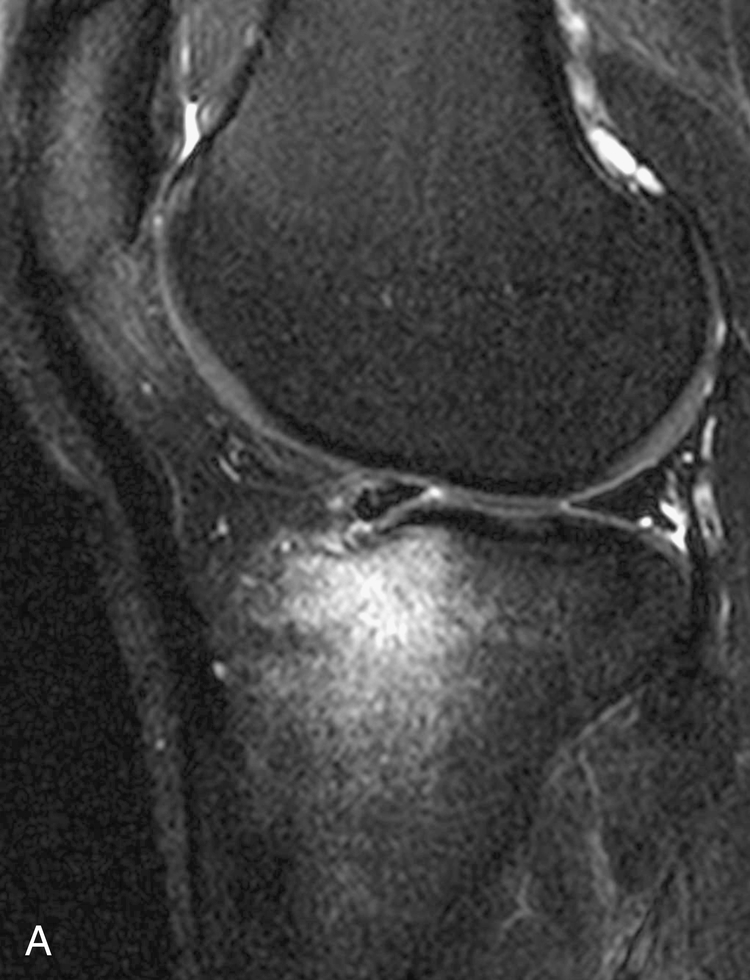
The gradient echo (TR variable; TE < 30 msec; flip angle = 10-80 degrees) family of pulse sequences was originally developed to produce T2W images in less time than was possible with a conventional spin echo technique. As their names imply, gradient echo and spin echo pulse sequences acquire images in different ways. Consequently, although fluid appears bright on gradient echo T2W images (designated T2*W) and (fast) spin echo–T2W images, the appearance of other tissues differs on the two sequences. Ligaments and articular cartilage are particularly well shown with gradient echo sequences, as are fibrocartilaginous structures such as the knee menisci and glenoid labrum. Contrast between other soft tissues is relatively poor, however, on gradient echo images.
Gradient echo imaging can be performed using a two-dimensional technique (in which slices are obtained individually) or a three-dimensional (3D) “volume” technique. In 3D imaging, the signal from an entire volume of tissue is obtained at one time, and these data can be partitioned into extremely thin (< 1 mm) slices such that the voxel dimensions are nearly isotropic (equal in all dimensions) ( Fig. 1.12 ). This technique allows for high-resolution imaging and is especially useful when evaluating extremely small structures, such as ligaments in the wrist. These 3D sequences also provide the ability to create reformatted images in virtually any plane without a significant loss of resolution ( Fig. 1.13 ). Although most 3D sequences require relatively long imaging times (introducing the potential for motion artifact), if the reformatted images are of adequate quality, other sequences may be omitted from the protocol, minimizing this effect.
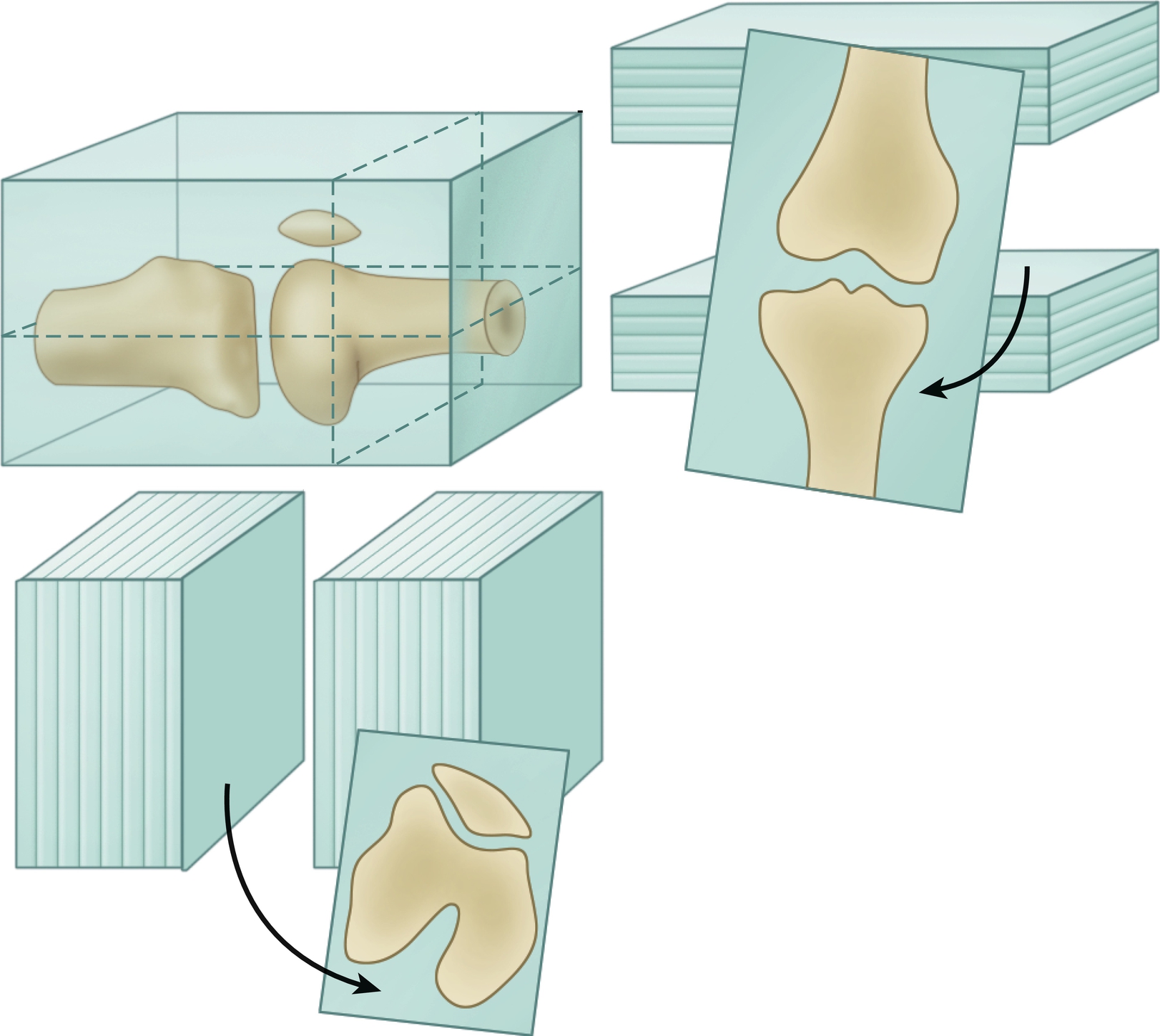
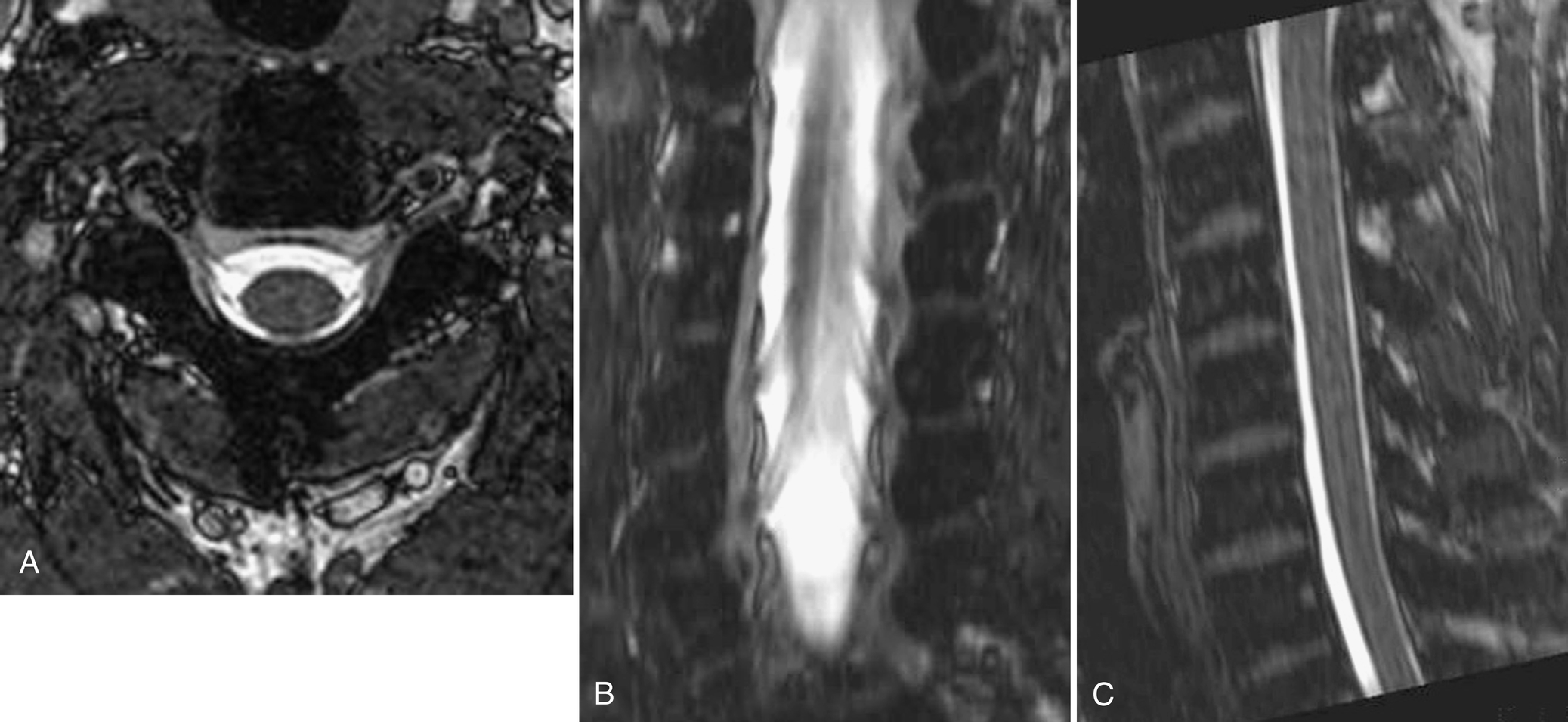
One feature of gradient echo sequences is a heightened sensitivity to susceptibility effects . This refers to artifactual signal loss at the interface between tissues of widely different magnetic properties, such as metal and soft tissue. This feature can be advantageous when searching for subtle areas of hemorrhage because these would be more conspicuous on gradient echo images due to susceptibility effects of the hemoglobin breakdown products within the tissue ( Fig. 1.14 ). Similarly, these sequences are useful for detecting loose bodies and soft tissue gas because of susceptibility effects.
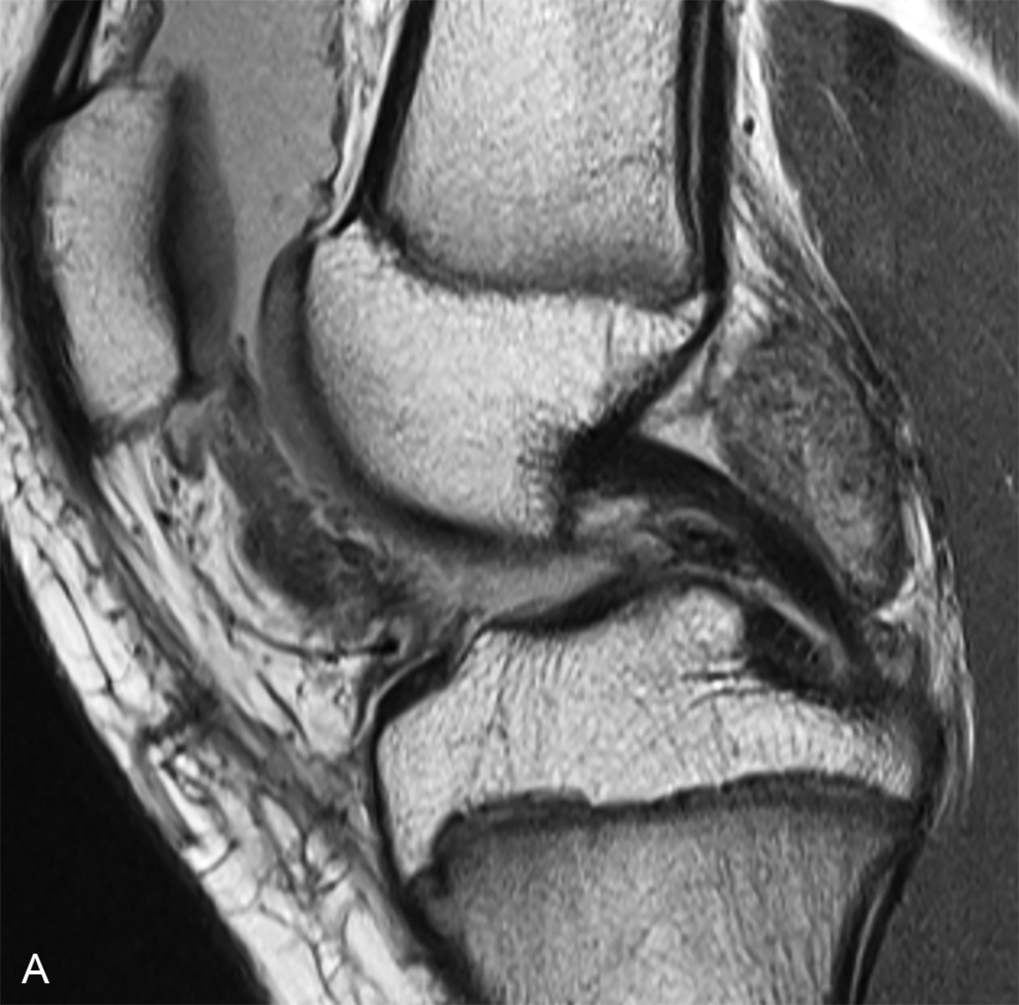
Conversely, drawbacks of these susceptibility effects include overestimating the size of osteophytes in spine imaging and missing marrow pathology when trabecular bone is not destroyed, because a susceptibility artifact at the interfaces between trabecular bone and marrow fat obscures the associated edema (see Fig. 1.11 ). Susceptibility effects can also be problematic when imaging patients with metallic hardware because of obscuration of adjacent normal tissue by the susceptibility artifacts. FSE sequences tend to minimize susceptibility artifacts and are useful when imaging patients with a history of prior surgery, especially if it is known that metallic hardware is present ( Fig. 1.15 ).
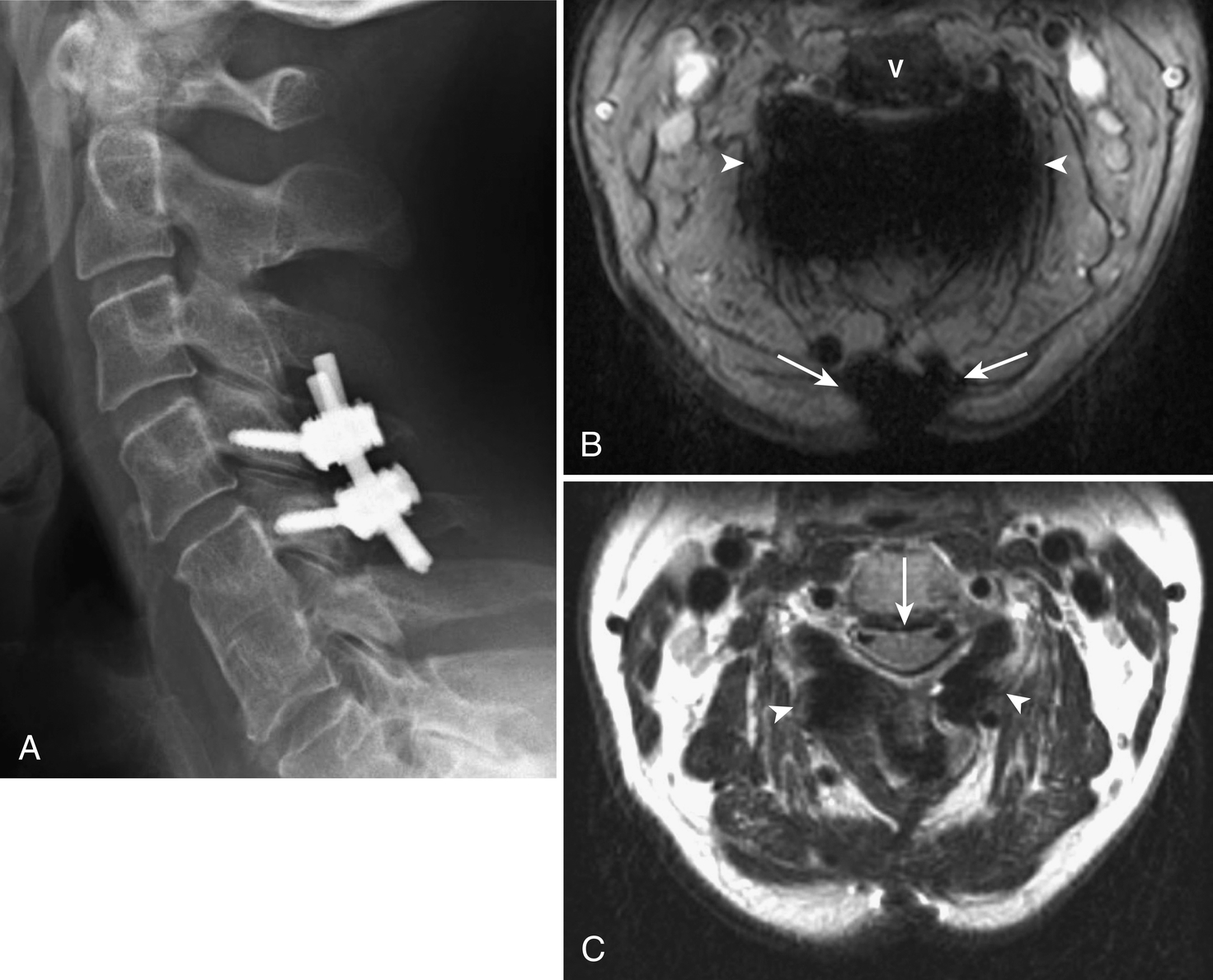
There are certain clinical situations in which it is advantageous to suppress the high signal intensity of fat. Two main techniques are used to accomplish this: frequency-selective (chemical) fat saturation and STIR imaging.
The frequency-selective technique exploits the differences in resonant frequencies between fat and water by applying a “spoiler” pulse at the frequency of fat. This pulse wipes out the signal from fat without affecting the signal from water. Likewise, the signal from Gd-DTPA (either IV or intra-articular) is preserved.
This technique can be used with T1W imaging to confirm the fatty nature of a mass ( Fig. 1.16 ) and to distinguish between fat and hemorrhage, since both would be bright on non–fat-saturated T1W images, but fat would suppress, whereas hemorrhage would not. After the IV administration of Gd-DTPA contrast material, fat-saturated images make tissue enhancement more conspicuous ( Fig. 1.17 ). Fat-saturated T1W images are also used with Gd-DTPA arthrography, allowing for the Gd-DTPA to be more conspicuously identified and improving diagnostic accuracy.
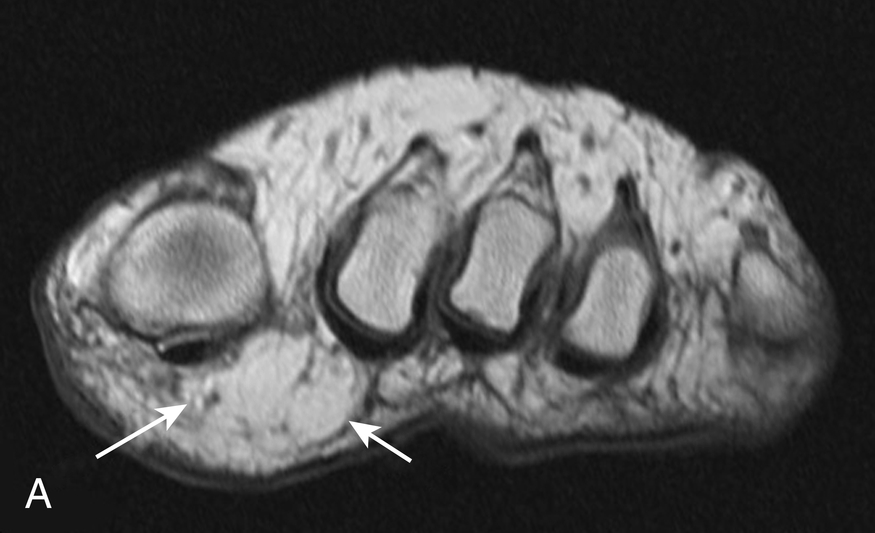
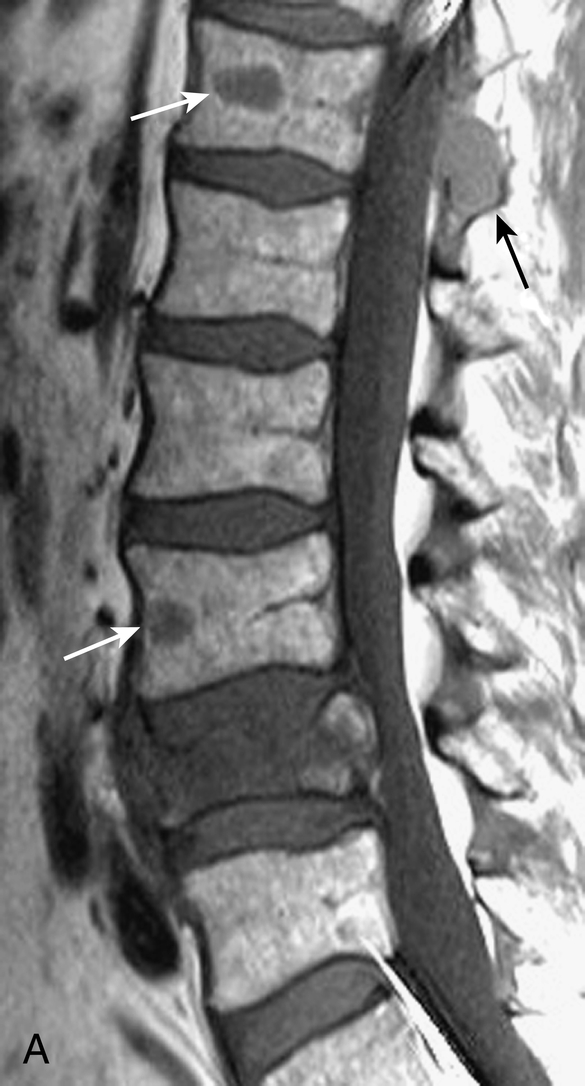
FSE-T2W imaging is often combined with frequency-selective fat saturation to highlight areas of soft tissue and marrow pathology because the high signal intensity of fluid and edema is extremely conspicuous against the dark background of suppressed fat. A major problem with frequency-selective fat saturation, however, is the potential for inhomogeneous suppression of fat signal. Because the technique is sensitive to magnetic field inhomogeneities and susceptibility effects, the fat saturation may be incomplete across an imaging volume; this may even result in inadvertent suppression of water signal in these areas. This failure of fat suppression is especially common along curved surfaces, such as the shoulder and ankle, and may result in spurious signal intensity that mimics pathology. This problem can often be identified by noticing the lack of suppression of the overlying subcutaneous fat signal in these regions, but it can be difficult to recognize and may result in diagnostic errors ( Fig. 1.18 ).
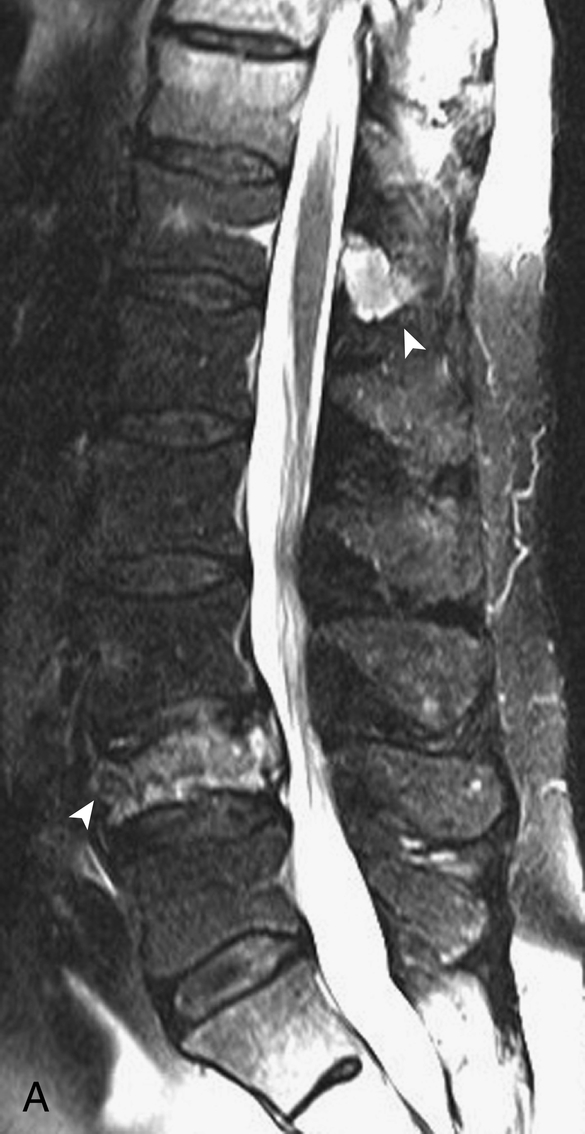
Frequency-selective fat saturation relies on adequate separation of the fat and water peaks, which occurs only at high field strengths (≥ 1.0 T). Consequently, another drawback of this technique is that it is not available on mid- and low-field-strength machines.
The inversion recovery (STIR) technique also results in fat saturation, but it is based on the relaxation properties of fat protons, rather than their resonant frequency, as is the case with frequency-selective fat saturation. Many clinicians use an FSE-T2W sequence with fat saturation rather than STIR imaging, and although these appear similar in terms of image contrast, there are some differences because the two techniques are based on different mechanisms. First, the STIR technique tends to produce more homogeneous fat suppression because it is not as sensitive to field inhomogeneity as the frequency-selective technique. Second, a STIR sequence should not be used with IV or intra-articular Gd-DTPA because the contrast agent has similar relaxation properties to fat protons, and its signal intensity would be saturated along with fat on the STIR images.
Gd-DTPA is a paramagnetic compound that shows increased signal intensity on T1W images. It has two major routes of administration: IV and intra-articular. Intra-articular use of Gd-DTPA in MR arthrography is discussed in the next section. IV Gd-DTPA should be used only for certain indications, especially in light of more recent reports of an apparent link between Gd-DTPA agents and a rare, but potentially devastating, condition called nephrogenic systemic fibrosis (NSF) or nephrogenic fibrosing dermopathy (NFD). This condition is most commonly seen in patients with poor renal function.
Mass: Cyst versus solid
Mass: Viable tumor versus necrosis (biopsy guidance)
Infection: Abscess versus phlegmon
Spine: Disk herniation versus scar within 6 months of surgery
When administered via IV, Gd-DTPA is analogous to iodinated radiographic contrast agents and results in enhancement proportional to soft tissue vascularity. Contrast enhancement is more easily evaluated on T1W–fat saturated images. By administering Gd-DTPA and applying fat saturation, however, two variables affecting tissue contrast have been changed, and care must be taken to avoid diagnostic errors. As an example, when pre–Gd-DTPA T1W images are obtained without fat saturation, a hematoma (higher in signal than muscle) may show apparent enhancement on T1W–fat saturated, postcontrast images, not because of true tissue enhancement, but because the subacute blood products within the hematoma may appear brighter because of the suppression of adjacent fat. Ideally, before administering Gd-DTPA, a precontrast fat-suppressed image should be performed.
IV Gd-DTPA is not administered for most musculoskeletal MRI examinations, but it is indicated in certain situations, as follows.
Become a Clinical Tree membership for Full access and enjoy Unlimited articles
If you are a member. Log in here